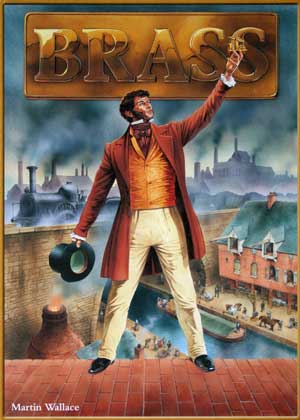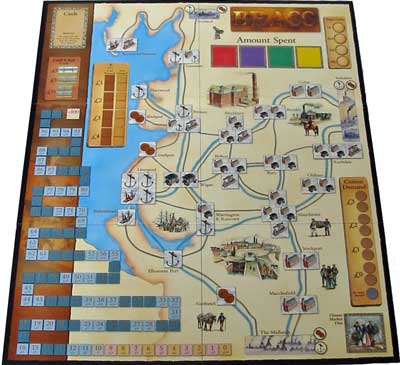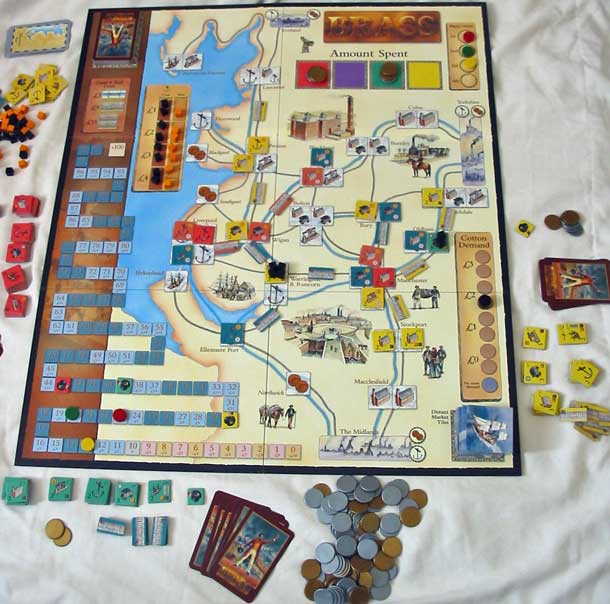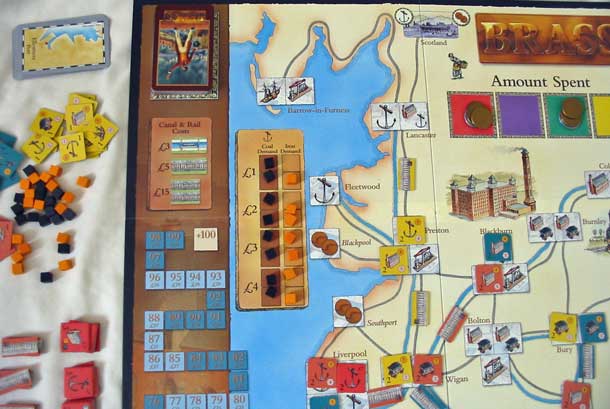Pevans
BrassReviewed by Pevans |
 The annual Warfrog game by Martin Wallace is always one of my highlights of the year. This yearís game is Brass, which is all about the Industrial Revolution in Lancashire. The mechanics of the game are a bit involved, so my explanation will have to be a bit involved, too. Do bear with me if
the going gets heavy.
The annual Warfrog game by Martin Wallace is always one of my highlights of the year. This yearís game is Brass, which is all about the Industrial Revolution in Lancashire. The mechanics of the game are a bit involved, so my explanation will have to be a bit involved, too. Do bear with me if
the going gets heavy.
Letís start with the physical components. The colour, mounted board is, of course, a map of Lancashire. It shows the major towns, with spaces where industries can be constructed, and the potential transport connections between them. There are also connections to areas north, south and east of Lancashire, tracks for coal, cotton and iron prices and an income/scoring track. The board is nicely illustrated to reflect the period. Each player has a set of double-sided tiles in their colour. Rectangular tiles are canals on one side and railways on the other. Square tiles are the industries available: coal mines, iron works, cotton mills, ports and shipyards. Players also have some markers and there are cubes for coal and iron and coins for money.
The game is controlled by a deck of cards, each of which shows either a specific town or a particular industry. Playersí actions are regulated by the cards and the game ends when the deck runs out for the second time. The first pass through the deck is the canal period: players can only build canals and use them to transport coal and cotton. The second half of the game is the railway period: players build and use railways. Players score victory points at the end of each period. They get points for the industries they have in play and for their canals or railways, according to what they connect.
Clearly, players have to build industries and transport and accumulate the most points. The tricky bit is just how you achieve this. For a start, an industry is only worth victory points when the tile has been turned over. The first side shows the cost of building the tile Ė in cash and, possibly, raw materials. It also shows the Ďtechnology levelí of the tile. A playerís industries are sorted in increasing technology level and must be played in this order. As youíd expect, the higher the technology level, the more it costs to build the tile. And the more victory points itís worth Ė shown on the flip side. Also on the back of the tile is the amount it increases a playerís income. This tends to go down as the technology level increases. I assume this is to balance the game and give the players the choice between income and victory points.
In their turn, players get to do two actions, playing a card for each of these. What card you play only matters when you are building an industry tile. A town card lets you build a tile in that town. It must be the same type as the space it goes on (some spaces give a choice) and, during the canal period, each player is limited to one tile per town. There are also a limited number of spaces at each town (though in certain circumstances you can replace an industry with a higher techno¨logy level version). An industry card lets you build that type of industry in any town Ė provided you have a transport connection to it. In either case, if the tile youíre building needs coal, you must be able to transport the coal there. You can use anybodyís canals/railways for this, there just needs to be a connection. Strangely, you donít need to ship iron. It just de-materialises and re-appears where itís needed.
The second of the actions available to players is building a canal/railway. These have a set cost and a railway requires coal as well. (This has to be shipped to one end of the new rail link.) You can only build these from a town where you already have an industry or a canal/rail link. You must play a card when you do this, but it can be any card. Similarly, you can play any card to take out a loan as an action. This can be 10, 20 or 30 cash, but your income is reduced by 1 for every 10 you take. My experience is that players will need at least one loan, probably during the canal period. It is possible to do without the extra cash, but this limits your options and how quickly you can build up your position.
 The fourth option is to Ďdevelopí your technology Ė and play a card. This action lets a player discard one or two of their unbuilt industry tiles, thus improving the technology levels available to them. Doing this uses up an iron cube, either from somebodyís iron works or from the external market (which costs money). As some tiles can only be used in the canal period, players will need
to take this action a few times to remove tiles they canít play. As a tactical move, itís worth considering doing this in the canal period. You can expect to score fewer points in the canal period, so using up an action Ďcostsí less. Level 1 industry tiles are removed from the board at the end of the canal period, but any higher-level tiles stay and will thus score twice.
The fourth option is to Ďdevelopí your technology Ė and play a card. This action lets a player discard one or two of their unbuilt industry tiles, thus improving the technology levels available to them. Doing this uses up an iron cube, either from somebodyís iron works or from the external market (which costs money). As some tiles can only be used in the canal period, players will need
to take this action a few times to remove tiles they canít play. As a tactical move, itís worth considering doing this in the canal period. You can expect to score fewer points in the canal period, so using up an action Ďcostsí less. Level 1 industry tiles are removed from the board at the end of the canal period, but any higher-level tiles stay and will thus score twice.
The final action available to players is selling cotton. This is how players turn over their cotton mill tiles to increase their income and provide them with some victory points. The (notional) cotton has to be shipped by canal/rail to a port. If the destination is a port tile, this is flipped too. It can be anybodyís port, gaining them some income and victory points as well. Of course, if itís your port, you get the income and points for both. As an alternative, players can sell their cotton to a Ďdistant marketí outside Lancashire. However, first they must flip a tile and adjust the bonus for exporting cotton. If this hits rock bottom, the export market is saturated and nobody can export any more. (This is re-set at the start of the railway period.)
Thatís how you flip (and thus score) cotton mills and ports, what about the other industries? When played, coal mines and iron works have a number of cubes placed on them. These gradually disappear as players use coal and iron. Once the tile is empty, it is turned over to score. If thereís no coal available in Lancashire, players can buy it from the import market, where the price increases as more cubes are taken. Thereís also an import market for iron. If a player constructs a coal mine (or iron works) when there are spaces in the import market, their coal (iron) is used to fill up the market and the player gets the cash. This is a useful tactical opportunity as a player may be able to empty a tile as soon as itís placed, earning victory points, income and cash.
Shipyards are rather different from the other industries. They flip as soon as they are played and, as they are worth a lot of victory points, this is well worth doing. However, there are a number of limitations to shipyards. First off, there are only three shipyard spaces on the board and correspondingly few cards that will let you build a shipyard. Whatís more, two of these locations can only be used in the railway period. Then there are the zero technology level shipyards. These are the first two tiles in your shipyard stack and you have to use a Development action to get rid of them. Each player then has two level 1 shipyards which can only be played in the canal period (though the symbol for this has been missed off the tiles). Only one of these, at most, will be played, so players will need another Development action to get to the level 2 tiles. My experience to date is that building more than one shipyard is likely to win you the game!
It is possible that the cards are really against you. In which case, you can use both cards as a wild location card. It means you only get one action in a turn, but sometimes you need to do it. Once each player has had their two actions, the player order for the next turn is determined by how much each has spent. Whoeverís spent the least gets to go first in the next turn. Hereís another tactical ploy: as last player, you can make sure you spend less than everybody else does. Youíll then be first in the next round, effectively giving you two turns in a row.
If there are cards left, players draw two each and start the next round. This begins with players taking their income Ė which can be negative if theyíve over-stretched themselves with loans. Once players have used all their cards, the current period ends and they score victory points. At the end of the canal period, the canals and level 1 industry tiles are removed from the board and the railway period begins. At the end of the railway period, points are scored again, players get a few points for any cash they have left and the gameís over. Whoever has the most points wins, of course.

Players start the game with zero income and 30 cash: clearly the first job is to increase your income. My initial thought was to build a coal mine, but this turned out to be not as good as I expected. First off, there isnít that much demand for coal in the canal period as most of the level 1 industries donít need it. Secondly, coal needs to be shipped along canals, so nobody can use the coal until the mine is connected into the network. However, as anyone can use canals (and railways) once theyíre built, you can always capitalise on what other people are building. Nor are you constrained to expanding your own network: town cards let you build in a town regardless of whether you are connected to it.
In the canal period, cotton mills and ports seem to be the most effective means of expansion. Remember, any player can use a port, so build a mill first. Then in one turn you can build a port and sell your cotton as your two actions and get the income and points for both. One wrinkle that I keep overlooking is that you can sell cotton from any number of mills in one action Ė though each needs an unused port or a turn on the distant market. And go for the distant market sooner rather than later as it will close down. The only restriction is that, again, your mills need to be connected to a port before you can ship. Building canals is cheap, but itís a means to an end rather than an end in itself.
I suggest that you carry out some Development actions in the canal period. In particular, clearing away the unplayable shipyards is a good move. Even more so if you have the opportunity (and the cash Ė it ainít cheap!) to build the one and only shipyard. The limiting factor here is the availability of the iron you need for the Development action. You can buy it from the external market, but that costs cash. Building an iron works makes iron available for free and, hopefully, all the iron will be used and youíll get some points for it. However, building an iron works needs coal, which means there must be a canal connection to ship it inÖ
The key to the game is taking advantage of what other people are doing. If someone builds a coal mine, use that coal to build an iron works. If someone builds an iron works, use that iron to throw some tiles away. And, above all, use the whole canal network, rather than trying to build it all yourself. Donít be afraid to take out a loan. The sooner you do this, the less it will cost you on the income track (each point of income you move back is more spaces the further along the track you are). Remember, too, that you have limited actions: use one action for a loan of 30, not three actions for three loans of 10.
The game really gets going when the railway period starts. To begin with, each piece of railway requires coal to build. Suddenly there is demand for coal. And that level 2 coal mine generates a decent amount of income. The really valuable industries need coal and iron to construct. More demand for coal and for iron, which is also required for Development actions. Tiles flip over quickly, income accelerates and suddenly the 25 you need to build a level 2 shipyard is sitting in front of you. There are three possible opportunities to build shipyards in the railway period: grab at least one. Finally, you have a limited number of actions, so plan how youíre going to use them.

As you can see, the game has a lot going for it, but I donít think itís one of Martinís best games. My main problem is that there are too many different things to remember. You need a canal to ship coal, but not iron. You need your own transport connection to build using an industry card, but not using a town card. You need any transport connection to build a tile that needs coal, but none if it doesnít. You can build in one town as many times as you want in the railway period, but only once in the canal period. Every game so far has ended with pieces on the board that shouldnít be there. I think the rules could have done with a bit of streamlining to reduce the differences.
My second issue is the luck factor of the cards. In the canal period, having multiple cards for the same town is pointless. Okay, itís easy enough to get rid of the extras, but they limit your options in the meantime. In the railway period, not having one of the cards needed to build a shipyard means youíre not going to win. And taking a few cards out of the deck each period (so that thereís an even number for the players) will occasionally mean that significant cards are missing. Now it may well be that I havenít played the game enough to see how to work round the luck, but itís bugging me at the moment.
Donít get me wrong, I think Brass is a good game and I continue to play it. However, I also think it could have been better. It is well produced and illustrated, with good, solid components (that only just fit back into the box). It provides a couple of hours of entertaining play and gives players tactical options and decisions to make. However, it has some rough edges that might have been smoothed off with a bit more development. Brass gets 7/10 on my highly subjective scale.
Brass was designed by Martin Wallace and is published by Warfrog. It is a strategy board game for 3-4 players, aged 13+, and takes 2-3 hours to play.
This review was first published in issue 82 of To Win Just Once, February 2008. A version was alos published in Flagship 124 (February 2008).